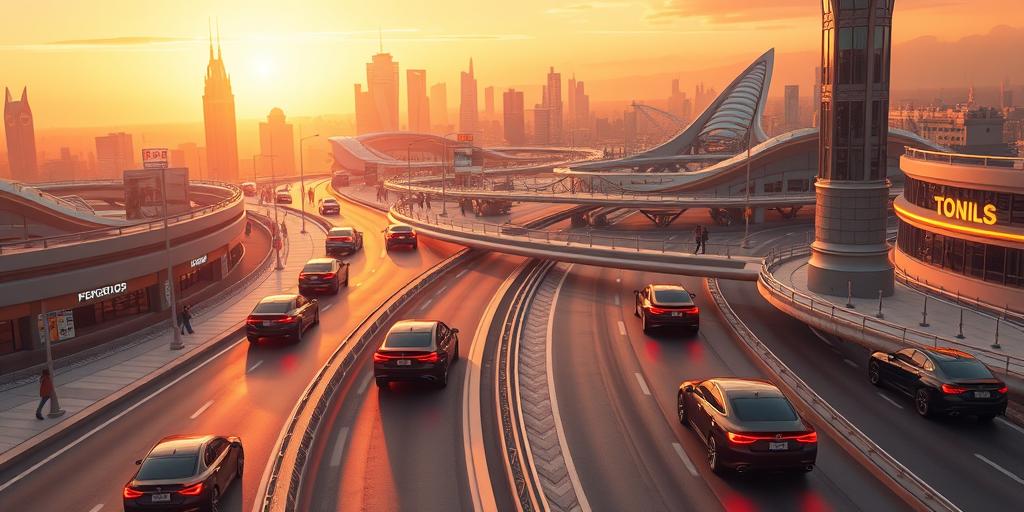Is the Internet of Things (IoT) poised to revolutionize the global transportation system? Buckle up, because we’re about to explore how this groundbreaking technology is transforming the way we move people and goods worldwide. From smart traffic management to autonomous vehicles, the IoT is rapidly changing the landscape of transportation.
Smarter Traffic Management: Reducing Congestion and Improving Flow
Imagine a world without traffic jams! Sounds utopian, right? The IoT is bringing that vision closer to reality with intelligent transportation systems (ITS). These systems leverage real-time data collected from various sources, such as connected cars, traffic cameras, and sensors embedded in roads, to monitor traffic flow, identify bottlenecks, and optimize traffic signal timing. This results in reduced congestion, faster commute times, and improved fuel efficiency. IoT-enabled ITS also allows for better emergency response times and dynamic routing, guiding drivers around accidents or other disruptions in real-time. The integration of GPS and IoT technology is particularly transformative for navigation apps, providing pinpoint accuracy and even predicting delays based on real-time data. This level of precision significantly improves the commuter experience, making travel more efficient and less stressful.
Advanced Analytics for Predictive Maintenance
Predictive maintenance is another significant advantage of IoT integration in transportation. IoT sensors embedded in vehicles and infrastructure can collect data on performance and wear-and-tear. This data is then fed into algorithms that analyze potential problems, allowing maintenance to be scheduled proactively. This helps prevent costly breakdowns, minimizes unexpected delays, and improves overall operational efficiency. This is particularly crucial in large-scale transportation networks where even minor disruptions can have a ripple effect.
Autonomous Vehicles: The Future of Transportation?
Autonomous vehicles, often referred to as self-driving cars, are perhaps the most visible application of IoT in the transportation sector. These vehicles use an array of sensors, cameras, and GPS to navigate and operate without human intervention. The underlying infrastructure, such as smart roadways and communication networks, is where the IoT plays a crucial role. The data gathered from these technologies can be used to further refine the algorithms that govern autonomous driving. The IoT enables communication between vehicles, infrastructure, and central control systems, ensuring safe and coordinated movement. While the widespread adoption of autonomous vehicles is still some years away, the technological advancements powered by the IoT are paving the way for a future where transportation is safer, more efficient, and more accessible for all.
Challenges in Autonomous Vehicle Deployment
Despite the exciting potential of self-driving cars, several challenges remain. Safety concerns are paramount, as the software and hardware must be impeccably reliable to guarantee the safety of passengers and pedestrians. Furthermore, issues of cybersecurity, data privacy, and regulatory frameworks need careful consideration. The infrastructure needed to support widespread autonomous vehicle adoption – including robust communication networks and smart road infrastructure – represents a substantial investment. Finally, societal implications, such as job displacement in the transportation industry, must be addressed proactively to ensure a smooth transition.
Enhancing Public Transportation with IoT
Public transportation systems are also poised to benefit significantly from IoT technology. Real-time tracking of buses and trains, coupled with predictive modeling, enables more accurate scheduling and improved service reliability. Passengers can use apps to track the arrival of vehicles, reducing wait times and improving the overall user experience. IoT sensors can also monitor the condition of vehicles and infrastructure, allowing for proactive maintenance and reducing disruptions. Smart ticketing systems, enabled by the IoT, can streamline payment processes and minimize the need for physical tickets. These improvements make public transport more attractive, ultimately leading to its increased adoption and a reduction in private vehicle use, which contributes to reduced congestion and environmental benefits.
The Environmental Impact of IoT in Transportation
One of the most significant potential benefits of IoT in transportation is its contribution to environmental sustainability. By optimizing traffic flow, improving vehicle efficiency, and promoting the adoption of public transport, the IoT can significantly reduce greenhouse gas emissions. Furthermore, the ability to monitor and manage energy consumption in vehicles and infrastructure allows for more efficient use of resources, reducing waste and environmental impact. The trend toward electric vehicles, which are inherently more sustainable, is further amplified by the IoT’s contribution to smarter energy management and charging infrastructure.
The Future is Connected: Embracing the IoT Revolution in Transportation
The integration of IoT technology is reshaping the global transportation system, paving the way for smarter, safer, and more sustainable mobility solutions. While challenges remain, the potential benefits are undeniable. From reducing congestion and improving traffic flow to enabling autonomous vehicles and enhancing public transportation, the IoT is driving a profound transformation in the way we move people and goods around the world. Embrace the connected future and explore the myriad possibilities that the IoT brings to the realm of transportation!
Are you ready to dive deeper into the innovative applications of IoT in transportation? Click here to learn more!




